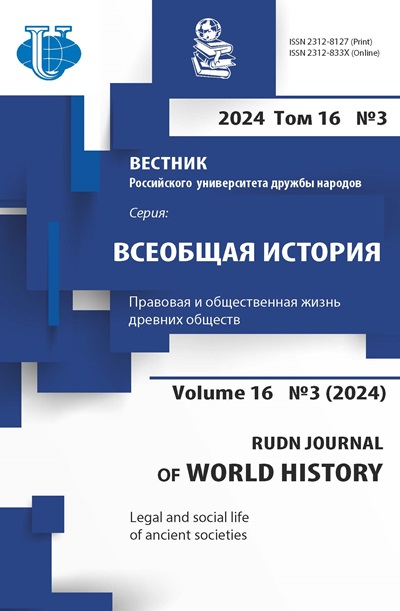No 2 (2009)
- Year: 2009
- Articles: 13
- URL: https://journals.rudn.ru/world-history/issue/view/126
Articles
Editor's Note
RUDN Journal of World History. 2009;(2):5-5
 5-5
5-5


Settlements, Dwellings and Economy of the Population of Northern Kazakhstan and Ural as the Decision of a Problem of Ethnic Belonging of Andronovskiy Tribes During the Bronze Age
Abstract
The huge territory of Central Asia between the Urals Mountain and the Yenisei till the Amudarya was populated by the tribes of Andronovskaya culture with no interruption during the Bronze Age. One of the major attributes, allowing establishing origin of ancient tribes and even cultures is the technology of potter's manufacture and decoration as they are specific at different ethnic groups. In conditions of house craft, traditions of manufacture are transferred and are steadily kept from generation to generation. This is true especially for the archaic culture, so this concerns all the peoples of the «steppe belt» of Eurasia and adjoining steppe and forest-steppe zones. This aspect is important for finding-out of an ethnic identification of Andronovskskiy population as it is the most numerous archaeological materials from settlements and from funeral monuments.
RUDN Journal of World History. 2009;(2):6-17
 6-17
6-17


The Decoration of Braziers of the Catacomb Culture: Analysis of Composition
Abstract
The article is dedicated to the analysis of the decoration on censers of the catacomb culture, which existed in Eurasian steppes in the Middle Bronze Age. As censer was a ritual vessel it was used in the funeral rite. Censer usually was richly decorated. The analysis of the composition and of the system of decoration on censers allow clarifying the semantic of whole funeral rite, find the basis of religious views of the catacomb population.
RUDN Journal of World History. 2009;(2):18-31
 18-31
18-31


The State of Ardashir I Papakan (224-241) and Its Supports
Abstract
This article deals with a crucial period in the history of early mediaeval Iran, that of the reign of Ardashir I Papakan, the founder of the Sasanid state. The goal of the study consists in identifying social and political forces which suppoerted the new state, and examining their relationship. The work presents a comparative analysis of data coming from the Sasanid times and information preserved in later narrative sources.
RUDN Journal of World History. 2009;(2):32-45
 32-45
32-45


Problems of Formation of Ancient Saxon Tribal Union
Abstract
Based on a wide range of written and archeological artifacts of the Middle Ages the article deals with a problem of genesis and formation of ancient Saxon tribal union. The formation of ancient Saxon ethnical and political union is studied in the process of its evolution starting from II century AD when it the first mentioned in the records until VI century AD when potestary institutes of the Saxon's came into being. Other factors such as the appearance of a new legitimate leader vividly demonstrate the dynamics of social and political relationships.
RUDN Journal of World History. 2009;(2):46-56
 46-56
46-56


Madrid Economic Society of Friends of the Country: its Foundation and Activities (1775-1808)
Abstract
The period of reform and 'enlightened despotism' in Spain of the XVIIIth century is studied in the article. This policy culminating in the rule of Charles III (1759-1788), focused on modernizing the Spanish government, infrastructure, and institutions. One of the aims was to establish «economic societies» - the most important of them was the Madrid Economic Society -dedicated to particular tasks required for a growing Spanish economy, mostly to encourage economic development and initiative and modernize Spain's education system. A number of important Spanish statesmen, social scientists and reformers participated in the activities of the Madrid Economic Society, which would not have been possible without the support of Spain's «enlightened despot» Charles III. In order to equip Spain for industrial development in the nineteenth century, subjects taught included chemistry, mineralogy, metallurgy, public architecture, agronomy, and political science. Experiments in agriculture, along with new crops and plant culture, helped increase the efficiency of Spanish agriculture.
RUDN Journal of World History. 2009;(2):57-68
 57-68
57-68


Socio-economic and Political Processes in Ecuador on the Eve of the Establishment of the Conservative Regime of Garcio Moreno
Abstract
The end of the XIX and the beginning of XX centuries was an important stage in the development of Latin America countries. This period was characterized by a fierce struggle between the conservative forces and the liberals who were the mouthpiece of the interests of the new bourgeoisie striving to do away with feudal barriers which hindered the development of the capitalist relations and whose aim was to come to power. The socio-economic situation in Ecuador during that period helps us to analyze the political and economical situation of the country in the future, the origin of «garcionism» as a socio-political event which made an accession of liberals to power a reality.
RUDN Journal of World History. 2009;(2):69-78
 69-78
69-78


«...The Kingdom of Heaven Belongs to Them». Spiritual Franciscans and the Origin of New Europe (Kerov V.L. Franciscans in France in the 13th century and the 14th century's First Half: Peter John Olivi and Spirituals Franciscans. - M., 2007)
RUDN Journal of World History. 2009;(2):79-81
 79-81
79-81


«I'm Proud to be the Graduate of this Great University»: Graduate Students of Peoples' Friendship University of Russia from Africa
RUDN Journal of World History. 2009;(2):82-88
 82-88
82-88


Graduates of the University, Specialists in the Middle East, Perceive Subtlety of the Diplomatic Work
RUDN Journal of World History. 2009;(2):89-92
 89-92
89-92


50 Years of Collaboration: Peoples' Friendship University of Russia and the Universities of Latin America
RUDN Journal of World History. 2009;(2):93-100
 93-100
93-100


Peoples' Friendship University of Russia and India: «I will never forget my studies at the University
RUDN Journal of World History. 2009;(2):101-104
 101-104
101-104


Our authors
RUDN Journal of World History. 2009;(2):105-105
 105-105
105-105
















